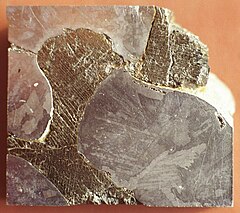Troilite
| Troilite | |
|---|---|

Polished and etched surface of the Mundrabilla meteorite from Australia. The darker brownish areas with striations are troilite with exolved daubréelite.
|
|
| General | |
| Category | Sulfide mineral |
|
Formula (repeating unit) |
FeS |
| Strunz classification | 2.CC.10 |
| Crystal system | Hexagonal |
| Crystal class | Ditrigonal dipyramidal (6m2) H-M symbol: (6m2) |
| Space group | P62c |
| Unit cell | a = 5.958, c = 11.74 [Å]; Z = 12 |
| Identification | |
| Color | Pale gray brown |
| Crystal habit | Massive, granular; nodular; platey to tabular |
| Cleavage | None |
| Fracture | Irregular |
| Mohs scale hardness | 3.5 - 4.0 |
| Luster | Metallic |
| Streak | Gray black |
| Diaphaneity | Opaque |
| Specific gravity | 4.67–4.79 |
| Alters to | Tarnishes on exposure to air |
| References | |
Troilite is a rare iron sulfide mineral with the simple formula of FeS. It is the iron rich endmember of the pyrrhotite group. Pyrrhotite has the formula Fe(1-x)S (x = 0 to 0.2) which is iron deficient. As troilite lacks the iron deficiency which gives pyrrhotite its characteristic magnetism, troilite is non-magnetic.
Troilite can be found as a native mineral on Earth, but is more abundant in meteorites, in particular those originating from the Moon and Mars. It is among the minerals found in samples of the meteorite that struck Russia on February 15th, 2013. Uniform presence of troilite on the Moon and possibly on Mars has been confirmed by the Apollo, Viking and Phobos space probes. The relative intensities of isotopes of sulfur are rather constant in meteorites as compared to the Earth minerals, and therefore troilite from Canyon Diablo meteorite is chosen as the international sulfur isotope ratio standard.
Troilite has hexagonal structure (Pearson symbol hP24, Space group P-62c No 190). Its unit cell is approximately a combination of two vertically stacked basic NiAs-type cells of pyrrhotite, where the top cell is diagonally shifted. For this reason, troilite is sometimes called pyrrhotite-2C.
A meteorite fall was observed in 1766 at Albareto, Modena, Italy. Samples were collected and studied by Domenico Troili who described the iron sulfide inclusions in the meteorite. These iron sulfides were long considered to be pyrite. In 1862 German mineralogist Gustav Rose analyzed the material and recognized it as stoichiometric FeS and gave it the name troilite in recognition of the work of Domenico Troili.
...
Wikipedia
